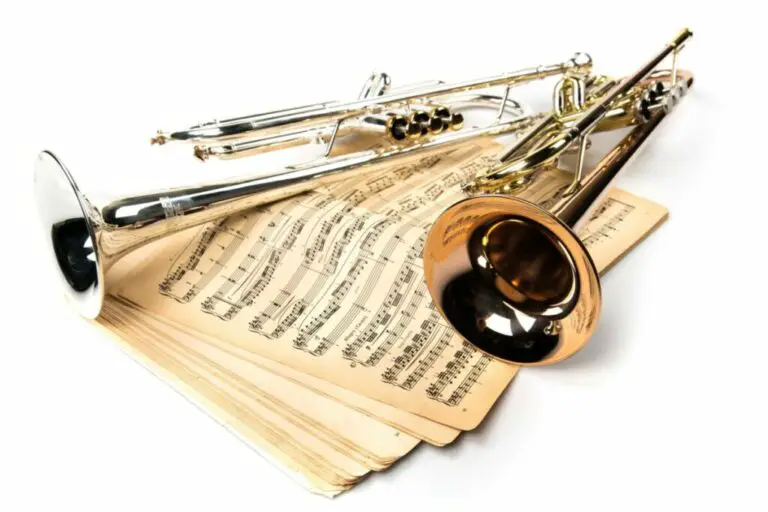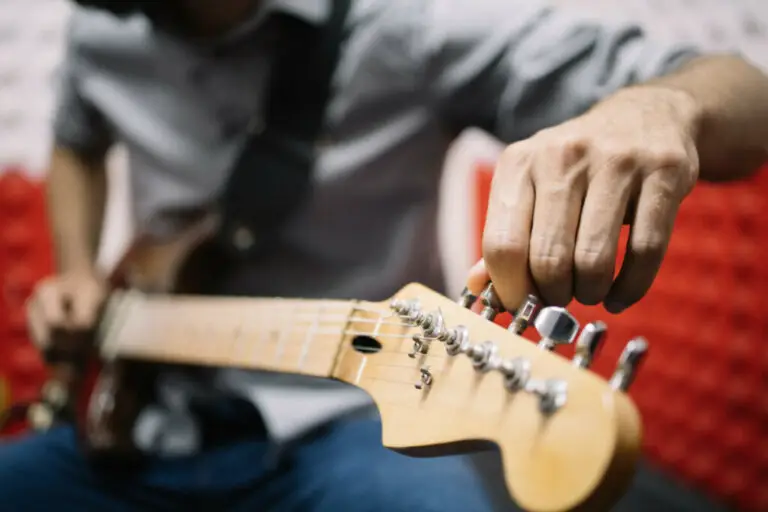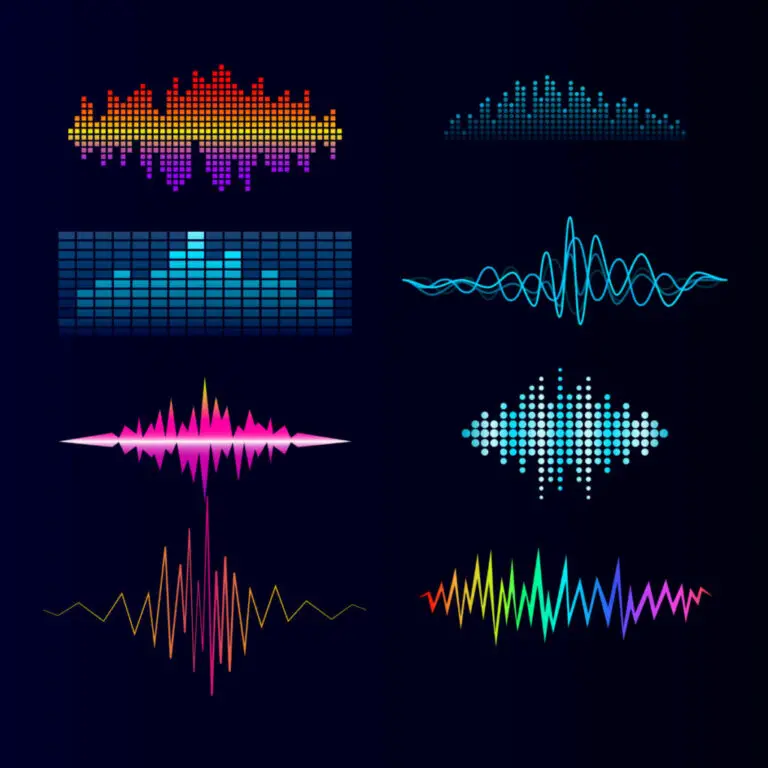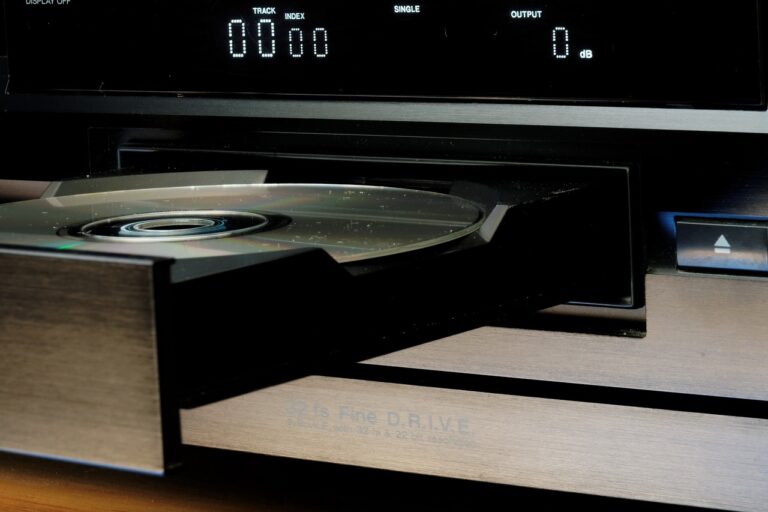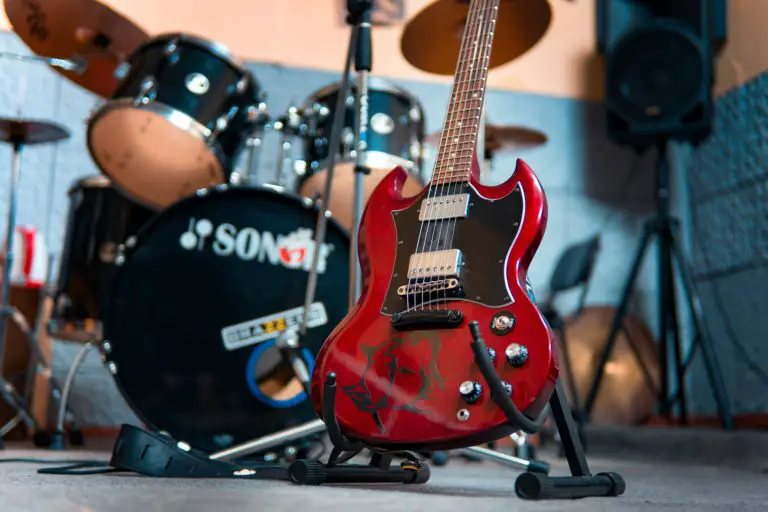Can You Play an Electric Guitar Through a PA System?

If you’re an electric guitar player looking to play at a live gig or record music, you’re probably familiar with using a guitar amp. But can you play an electric guitar through a PA system instead?
An electric guitar can be played through a PA system. A PA system has advantages over a guitar amp, such as greater versatility. However, using a PA system for a guitar requires some special adjustments to achieve optimal sound quality.
Below, we’ll let you know more about plugging PA systems into different guitars.
Why You Can’t Just Plug an Electric Guitar Into a PA System
Electric guitars are unique beasts. So, unfortunately, electric guitars require extra tools to ensure the sound source is enough to be “heard” by the PA system.
When plugging an electric guitar directly into your PA speaker, it will very likely sound terrible. This is because the signal of electric instruments is naturally weak. They need amplifying by external sources.
Typically, these tools come in one of two forms: an amp emulator or an amp modeler.
What is an Amp Emulator?
An amp emulator emulates an electric guitar amp. It’s a software program you can download on your laptop or mobile phone.
This way, you can go from guitar, to computer, to PA system. The computer takes the place of the amplifier, boosting the signal so the PA can hear it.
Amp emulators also have similar effects pre-amplifies. For example, a preamp pedal can adjust the guitar distortion, creating a unique metal sound.
But emulators do not have the same sound quality as their real counterparts. They lack the tone control and sound quality you expect from devices built specifically to boost your musical instrument.
Sometimes, people use digital audio workstations (DAWs) to edit the sound. Some of these DAWs lack the tools for creating unique guitar sounds.
An amp modeling unit is a better alternative.
What is an Amp Modeler?
An amp modeler is a device that models an amp. They are the hardware version of amp simulators, meaning you can expect a much higher quality of sound.
Because they are external devices, they are more expensive than the software variant. They also have more flexibility, supporting a wide range of sounds that include everything from your classic distortion pedal to a more clean sound closer to studio monitors.
Like the computer, a modeler acts as a middle person to your PA, amplifying the sound enough so the PA can hear it. It’s like having a separate preamp, only the modern is more useful for plugging indirectly into speakers. It’s like having a combo amp that doesn’t make any noise.
When following the steps below, adjust them to include your modeler or software amp.
How to Play a Guitar through a PA System [in Five Steps]
Playing guitar through a PA system can be a great way to spread your sound and reach a larger audience. There are two ways to do this, and the first way (listed below) will give you better sound.
1. Check your guitar’s output jack:
Before connecting your electric guitar to a PA system, you must ensure that your guitar has an output jack. Most electric guitars have a 1/4″ output jack that can connect the guitar to an amplifier or a PA system. If your guitar doesn’t have an output jack, you may need a pickup or microphone to amplify the sound.
2. Choose the right cables:
You’ll need two cables to connect your guitar to a PA system: a guitar cable and an XLR cable. The guitar cable will connect your guitar to a direct box or preamp, while the XLR cable will connect the direct box or preamp to the PA system.
3. Connect your guitar to a direct box or preamp:
A direct box or preamp is a device that helps to convert the high-impedance signal from your guitar into a low-impedance signal that can be sent to the PA system. To connect your guitar to a direct box or preamp, plug one end of the guitar cable into your guitar’s output jack and the other into the direct box or preamp.
4. Adjust your sound:
Once your guitar is connected to the PA system, you must adjust your sound to get the best tone. Start by adjusting the volume on your guitar and the direct box or preamp. Then, use the EQ controls on the PA system to adjust the bass, mid, and treble frequencies until you find the right sound for your playing style.
5. Test your sound:
Before you start playing, it’s important to test your sound to ensure everything is working properly. Play a few chords or notes and listen for any distortion or feedback. If you hear any issues, adjust the volume, EQ, or other settings until you get a clean and clear sound.
Here’s a video showing you a similar setup:
The Second Way To Play Your Guitar Through a PA System
If you don’t want to overcomplicate matters or can’t buy new equipment, your alternative to connect guitars and PA speakers is to put a mic up to your guitar amplifier. This will produce a lower-quality sound but skip many of the steps above.
You’ll want a dynamic microphone and high-quality speakers to get this done. From there, you’ll need to turn down the amplifier and move it away from your speaker output. Ideally, the guitar amp is isolated from the other sound.
If you keep the amp in the same room as the speakers, you’ll create a terrible feedback loop.
You should only choose this option if you have an amp that lacks the watts of power necessary to fill the room. A PA system acts as a secondary speaker in this case.
Can You Plug an Acoustic Guitar Into Your PA System?
Acoustic guitar amps also exist, but they don’t behave the same as electric guitar amps. Because the sound source behind acoustic guitars isn’t as weak as electric guitars, you can plug acoustics into PA systems without much difficulty.
Of course, you’ll want to check the in-house sound of where you’re playing before assuming anything. Sound checks ahead of schedule will help you catch problems before they become huge.
Can You Plug a Bass Guitar Into Your PA System?
Bass guitars use bass amps, which are uniquely built to handle incredibly low bass tones. This means PA systems cannot handle bass guitars by themselves. However, you can solve this problem with a DI unit.
A DI unit, sometimes called a direct input box, is a beautiful little device that converts your bass guitar’s noise into something manageable for the PA system. Some PA systems built for music already have these included, so check your owner’s manual.
If they don’t, you can buy them separately, as they are often used by recording studios for similar reasons. Much like electric guitars, the DI box is between the guitar and speaker cables, meaning it’s not much different from the amp simulators we’ve already gone through.
Differences between Guitar Amps and PA Systems
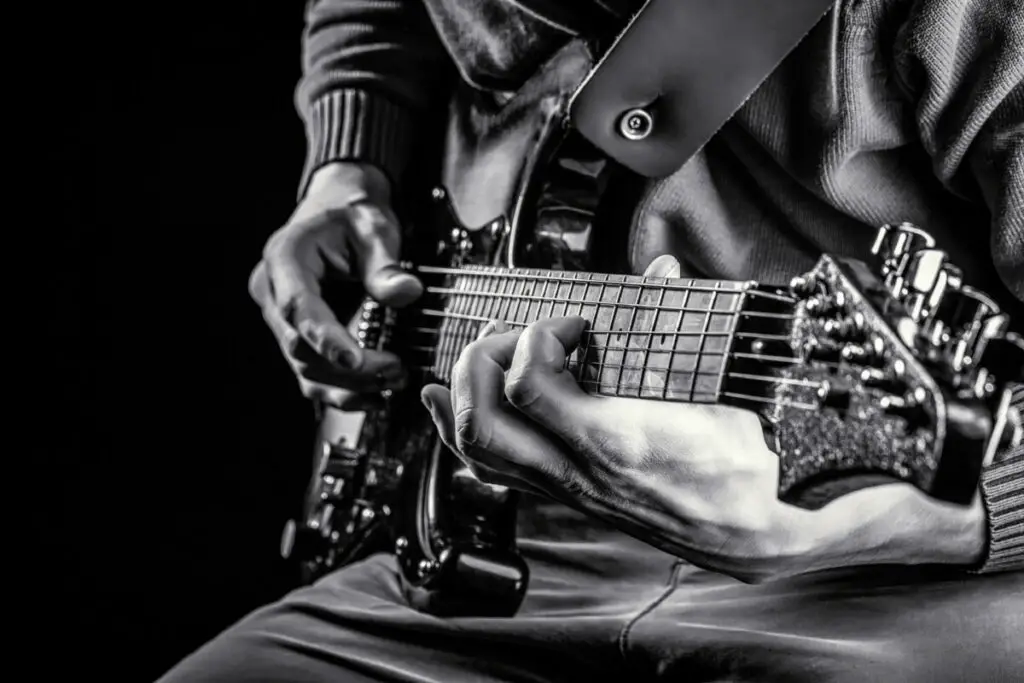
When it comes to amplifying your electric guitar, there are two main options: a guitar amp or a PA system. Both options have advantages and disadvantages. Understanding their differences is important to make the best choice for your needs.
A guitar amp is a specialized amplifier designed to amplify the sound of an electric guitar. Guitar amps typically have a preamp, which helps shape the guitar signal’s tone, and a power amp, which provides the necessary power to drive the speakers. Guitar amps are designed to be portable and often used by musicians in various settings, from small gigs to large concerts.
A PA (or “public address”) system is a type of sound system used to amplify various audio sources, including microphones, instruments, and recorded music. PA systems typically consist of a mixer, which allows the user to adjust the levels and EQ of each audio source, and a power amp, which provides the necessary power to drive the speakers. PA systems are designed to be versatile and can be used in various settings, from small venues to large outdoor events.
Differences between guitar amps and PA systems
- Sound Quality: One of the main differences between guitar amps and PA systems is sound quality. Guitar amps are specifically designed to amplify the sound of an electric guitar and often have a distinct “tube” or “solid-state” sound. PA systems are designed to be more neutral and transparent to reproduce a variety of audio sources accurately.
- Portability: Another difference between guitar amps and PA systems is portability. Guitar amps are often smaller and more compact than PA systems, making them easier to transport and set up. PA systems, on the other hand, are often larger and more complex, making them better suited for larger venues and events.
- Versatility: PA systems are more versatile than guitar amps, as they amplify various audio sources, including microphones, instruments, and recorded music. Guitar amps, on the other hand, are specifically designed for electric guitars and may not be suitable for other types of instruments or audio sources.
When to Use a Guitar Amp
Guitar amps are best suited when you want a specific tone or sound from your electric guitar. If you’re playing in a small venue or recording in a studio, a guitar amp can provide the necessary amplification and tone shaping to achieve the sound you’re looking for.
When to Use a PA System
PA systems are best suited for amplifying multiple audio sources, including microphones, instruments, and recorded music. If you’re playing in a larger venue or outdoor event, a PA system can provide the power and versatility to ensure the audience hears your sound.
Five Advantages of Using a PA System for Electric Guitar
There are several advantages to using a PA system with an electric guitar. Here are the top five benefits.
1. Greater Versatility
One of the biggest advantages of using a PA system for electric guitar is its greater versatility. While guitar amps are designed specifically for electric guitars, PA systems can amplify various audio sources, including microphones, other instruments, and recorded music. This means you can use a single PA system for all your amplification needs, making it a more cost-effective and practical option.
2. Better Sound Quality
Another advantage of using a PA system for electric guitar is that it often produces better sound quality. While guitar amps are designed to shape the tone of an electric guitar signal in a particular way, PA systems are designed to be more neutral and transparent. This means that the sound of your electric guitar will be reproduced more accurately, with fewer colorations or distortions.
3. More Power
PA systems can also provide more power than guitar amps, which is important if you’re playing in a larger venue or outdoor setting. With a PA system, you can ensure that your electric guitar is heard loud and clear, even over the noise of a large crowd.
4. More Control Over Your Sound
PA systems also offer more control over your sound than guitar amps. With a mixer, you can adjust the levels and EQ of each audio source, allowing you to shape the sound of your electric guitar in a more precise and nuanced way. This can be especially important if you’re playing in a larger venue where the acoustics may be challenging.
5. Ability to Work with a Sound Engineer
Using a PA system for electric guitar allows you to work with a sound engineer to achieve the best possible sound.
Five Tips for Achieving Optimal Sound Quality through a PA System
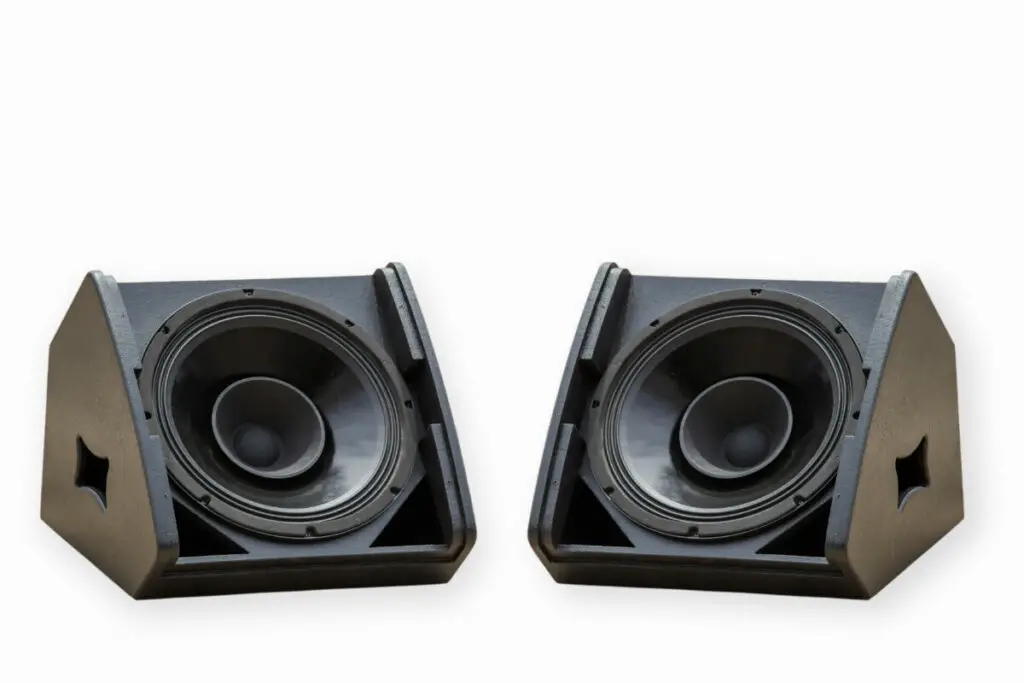
Playing an electric guitar through a PA system can be a great way to achieve optimal sound quality and project your sound to a larger audience. Here are some tips for achieving the best possible sound when using a PA system with your electric guitar:
1. Choose the Right Pickup:
The pickup you use on your electric guitar can greatly impact the sound quality when played through a PA system. Single-coil pickups often sound brighter and more articulate, while humbucker pickups provide a thicker, more saturated sound. Experiment with different pickups to find the one that works best for your sound and the music you’re playing.
2. Use Quality Cables:
High-quality cables to connect your guitar to the PA system are essential for achieving optimal sound quality. Invest in a good quality instrument cable and ensure it’s properly shielded to reduce interference and noise.
3. Adjust the EQ
Using the EQ controls on the PA system can help you fine-tune your sound and achieve the best possible tone. Experiment with different settings to find the right balance between bass, midrange, and treble frequencies, and adjust the levels to suit the acoustics of the room you’re playing in.
4. Set Appropriate Gain Levels
Setting the appropriate gain levels on the PA system is crucial for achieving optimal sound quality. Too much gain can lead to unwanted distortion and feedback, while too little gain can result in a weak or thin sound. Experiment with different gain settings to find the sweet spot that best balances volume and sound quality.
5. Work with a Sound Engineer
Working with a sound engineer can be an invaluable way to achieve the best possible sound quality while using a PA system with your electric guitar. A sound engineer can help you fine-tune your sound, adjust the levels, and troubleshoot any issues during your performance.
Wrap Up
By following these tips, you can achieve optimal sound quality when playing your electric guitar through a PA system. Whether you’re playing a live show or recording in the studio, a little bit of extra attention to detail can go a long way in helping you achieve the best possible sound.


